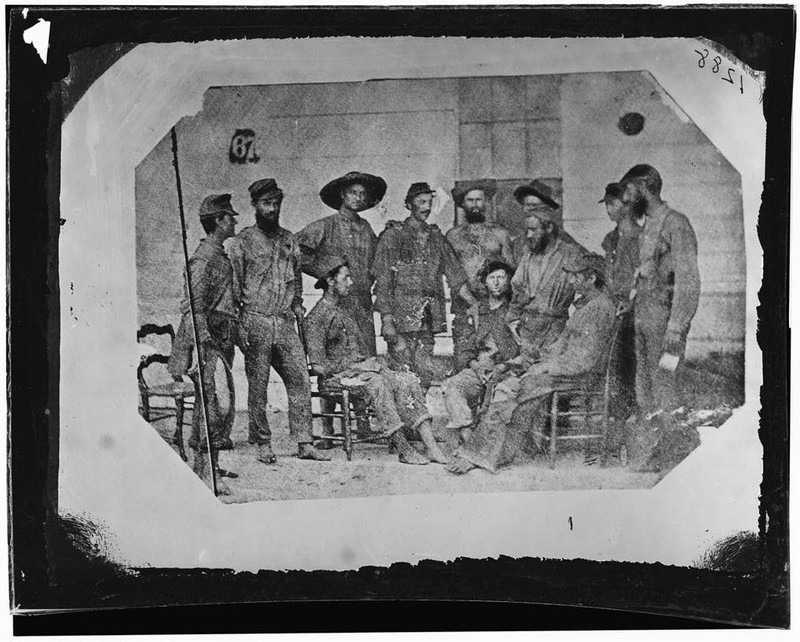Camp Ford
Introduction
Text-to-speech Audio
Named for John Salmon "Rip" Ford, Camp Ford was the largest Confederate Prisoner of War camp west of the Mississippi River. Ford, who was a lawyer, doctor, and ranger, was the state conscript commander who enlisted and trained soldiers for the Confederacy during the Civil War. About 6,000 Union prisoners, Confederate guards, and African-American slaves lived at the stockade. Today, the Camp Ford is a historic park managed by Smith County Historical Society.
Images
"19th-iowa-nco-prisoners" by Library of Congress - Library of Congress. Licensed under Public Domain via Wikimedia Commons - https://commons.wikimedia.org/wiki/File:19th-iowa-nco-prisoners.jpg#/media/File:19th-iowa-nco-prisoners.jpg

Backstory and Context
Text-to-speech Audio
After Camp Ford was established in 1862, the Trans-Mississippi Department sent the prisoners of war, who were located in Shreveport, Louisiana, there the following year. The POW were sent there in July, and until November they camped in the open under Confederate guard; however, it was rumored that the prisoners were planning an escape, so a stockade covering two to four acres was constructed. Along the side of the south wall of the enclosure was a natural spring and it supplied the camp with water, while the prisoners themselves were responsible for constructing their own shelters: many of them used logs and whatever other natural material they could find to do so. According to The Handbook of Texas, "Enterprising prisoners made goods for use and sale, including crude furniture, clay dishes, woven baskets, brooms, clothing, and other useful articles. Some of these were traded or sold to local citizens for food and clothes."
In 1864, after the Confederate victories at the battles at Mansfield and Pleasant Hill, approximately 3,000 prisoners were added at Camp Ford causing extremely uncomfortable living conditions, despite the expansion of the stockade to double its original size. According to the Handbook of Texas, the prisoners had little food and their shelters were falling a part. "The prisoners improvised all sorts of crude shelters ranging from brush arbors to blanket tents. Some simply dug holes in the ground for protection from the cold winds. A popular form of shelter was called a 'shebang,' a burrow into a hillside covered by a crude A-shaped framework made of poles, sticks, and clay to protect the entrance." Additionally, the POW usually only had the clothes that they were captured in, but thanks to a letter written by the ranking Union officers at Camp Ford, the federal government sent a few shipments of clothes for distribution among the thousands of prisoners.
Of the 6,000 inmates that were contained at Camp Ford during the two years it was in operation, 268 died there. The 1,200 that were there when the Confederate Trans-Mississippi Department surrendered were released and went back to Shreveport.
After the Civil War ended, a number of the released prisoners filed charges against the Confederates for the way they were treated at Camp Ford, but due to conflicting accounts, none of the charges against the Confederates were succesfully carried through.
In 1864, after the Confederate victories at the battles at Mansfield and Pleasant Hill, approximately 3,000 prisoners were added at Camp Ford causing extremely uncomfortable living conditions, despite the expansion of the stockade to double its original size. According to the Handbook of Texas, the prisoners had little food and their shelters were falling a part. "The prisoners improvised all sorts of crude shelters ranging from brush arbors to blanket tents. Some simply dug holes in the ground for protection from the cold winds. A popular form of shelter was called a 'shebang,' a burrow into a hillside covered by a crude A-shaped framework made of poles, sticks, and clay to protect the entrance." Additionally, the POW usually only had the clothes that they were captured in, but thanks to a letter written by the ranking Union officers at Camp Ford, the federal government sent a few shipments of clothes for distribution among the thousands of prisoners.
Of the 6,000 inmates that were contained at Camp Ford during the two years it was in operation, 268 died there. The 1,200 that were there when the Confederate Trans-Mississippi Department surrendered were released and went back to Shreveport.
After the Civil War ended, a number of the released prisoners filed charges against the Confederates for the way they were treated at Camp Ford, but due to conflicting accounts, none of the charges against the Confederates were succesfully carried through.
Sources
http://knue.com/historical-landmarks-in-east-texas-our-top-6/
https://tshaonline.org/handbook/online/articles/qcc15
